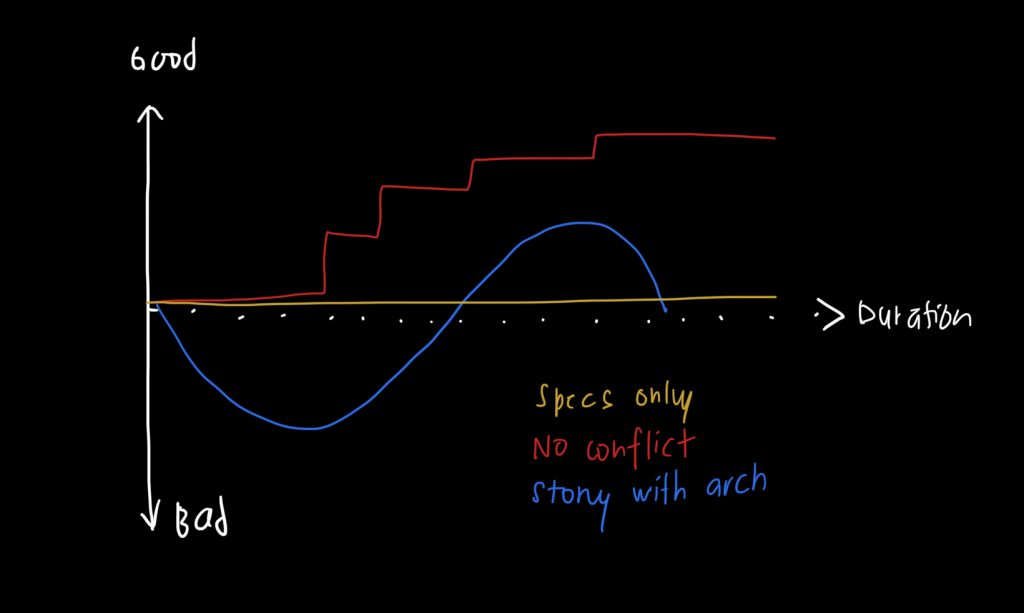Storytelling, story selling, soft selling, whatever you want to call it. Let's get to the bottom of it.
In short, it all leads to the same thing, "storytelling".
We can choose to be as complex as possible, or take a minimalistic approach. (I prefer the latter).
In its purest form, a story requires 3 major components.
A story will suck if there's neither of these components.
Knee injury was caused by excessive use. The easiest way to overcome is by strengthening quadricep and ice it.
Without hero, the text above sounds academic.
One day while I was running, a car passed me by and shouted, "get of the road".
Without ending, the story is hanging.
When he got his life in order, he made millions.
Without a problem, the story is less colourful.
This is how a story looks like, visually.

In Netflix - The Mind, Explained. In order to remember better, Yanjaa (Memory Champion) turn the details into a series of stories.
Stories make it easier for the receiver to remember.
We recall using story and speak using story.
If we just stick to 3 components, our stories would be really short. It's fitting for daily conversation. For marketing, we require a higher degree of finesse.
For that, we turn to 5C.
We must read the situation.
Where are they consuming the story?
Where are we telling it?
Who is listening to it?
Who is the audience?
Do they understand certain lingo?
Can they understand your language?
Will there be interruptions?
It doesn't make sense to tell jokes at an open casket funeral.
Nor explain in great detail about floating poops while eating.
Similarly, the story on the Main page of the website is different from a blog post, social media post or Twitter in terms of length, duration, cadence, universal language etc.
Read the situation well.
Who is the good guy?
In marketing, we are never the good guy. The audience is always the good guy aka Hero. Whether it's a testimonial story, case studies, white paper, product page.
The story must make the audience feel like it's them.
"This is me, they are talking about me, I'm the hero here".
The more connected you are to your audience, the more they will listen and stay till the end of your story.
Who is the bad guy?
What happened?
Who is the culprit?
It doesn't have to be a person. Anything bad which introduce conflict is the one that we should bring forth.
Naturally, try sticking to one major conflict.
Also, tell what happens when the conflict is not addressed.
What solution did the hero use?
What change did the hero introduce?
For this part of the story, we introduce the product or service that the hero uses.
We could also mention the alternative to the cure and logical reasoning behind the chosen path.
Finally, every story needs an ending.
What happens when they chose the cure?
How long did it take?
What was the key success metric that they measured?
Conclude, not summarise the story. Big difference here.
Finally, your CTA. How do they buy the product? What do they have to go through?
Without 5C
Muscle tape for knee joints. No heat, easy stick, reusable. Buy 1 get 1 free.
With 5C
Do you like running but suffering from knee and joint pain? Either keep using knee guard or use our muscle tape, which doesn't absorb sweat, lightweight and reusable.
You can enjoy running and get personal best time.
Don't buy now, get a trial pack for free.
Though a bit longer, it gives move context about the 'muscle tape' (personally I've never used it).
Without 5C, you'd probably need to compete in pricing because consumers are comparing spec-to-spec, which sucks.
Sure, we don't really want our brand to be associated with negative imagery. But without conflict, your story lacks colour. Conflict shapes the audience's emotion.
People buy with emotion, justify with logic.
Even big brands do it
Without a story, our copywriting will be limited to bullet points.
After going through the comparison with other products, our conversion rate is going to drop. Plus, not many people are able to remember every point.
Use story in your copywriting, your ads, your website, your social media.
It makes a huge difference if you have never done one.
The quickest way to learn storytelling is by doing. I practise mine on Twitter.
Follow @edwinmasripan